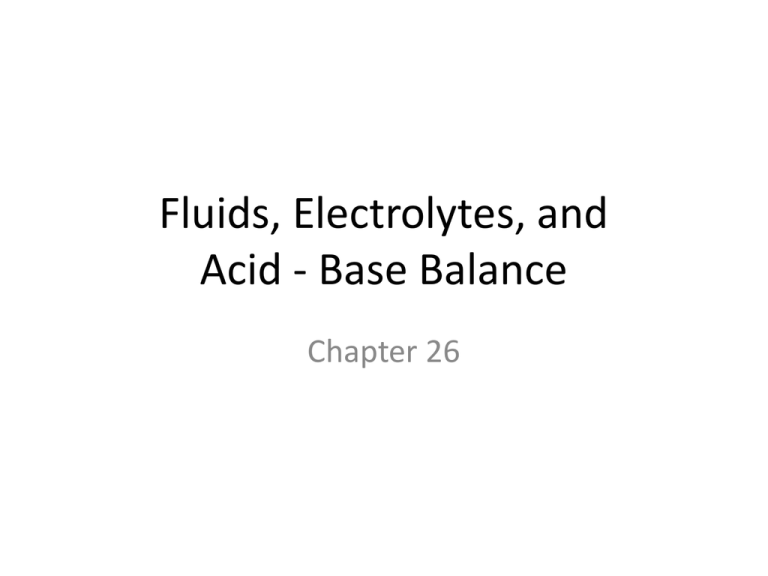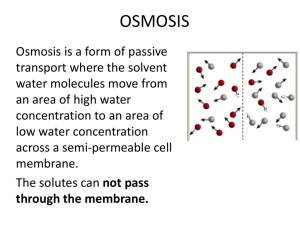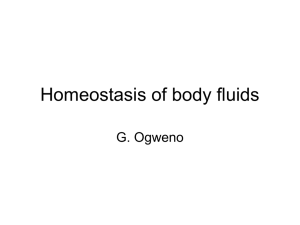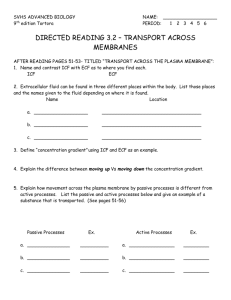Fluid and Electrolyte Balance
advertisement

Fluids, Electrolytes, and Acid - Base Balance Chapter 26 BODY FLUIDS Body Water Content • Largest component in body • Fxn of age, mass, sex, and body fat – Adipose tissue ~ 20% – Skeletal muscle ~ 75% • Infants ~ 73% – Low fat and mass • Young men and women ~ 60% and 50% – Relationship of adipose to muscle Fluid Compartments • Intracellular fluid (ICF) ~ 2/3 H20 volume • Extracellular fluid compartment (ECF) ~ 1/3 H2O volume – Plasma – Interstitial fluid (IF) • Other ECF – Lymph – CSF – GI secretions – Synovial fluids Composition of Body Fluids • Nonelectrolytes – Bonds prevent dissociation in H2O = no charge – Glucose, lipids, and urea • Electrolytes – Dissociate in H2O = charge = conduct electricity • Inorganic salts, acids and bases, and some proteins • Cations w/ (+) charge, anions w/ (-) charge – Greater contribution to fluid shifting (osmolality) Comparing Compartments (ECF vs ICF) • All ECF similar – Exception proteins b/c to big to diffuse – [Na+] and [Cl- ] predominate – Non-electrolytes ~ 90% & 60% in plasma & IF • ICF – [K +] and [phosphate] (HPO42-) predominate – [Na+] and [Cl- ] lowest • Na +/K + pumps • Renal reabsorption enhances – Non-electrolytes ~ 97% • Fig 26.2 Fluid Movement • Blood and IF exchange at capillaries* – HPb forces protein-free plasma out into IF – OPb sucks H2O out of IF (nondiffusible proteins) – Lymph removes minimal excess • IF and ICF more complex b/c of PM – H20 responds bidirectionally to [gradients] – Ions by active or facilitated transport – Nutrients, gases, and wastes move unidirectionally WATER BALANCE Hydration • Intake must equal output ~2500 ml • Increased plasma osmolality (high solutes) = thirst and ADH release dark urine • Decreased plasma osmolality = inhibits above light/clear urine Regulating Intake • Thirst mechanism stimulates drinking – Regulated by hypothalamic osmoreceptors • Increased plasma osmolality causes H2O loss to ECF – Dry mouth from decreased saliva production – Decreased plasma volume – Angiotensin II (Na+ reabsorption) • Moistening of GI mucosa and distension GI tract inhibit – Prevents overconsumption or overdilution – Not fail proof (exercise, heat, athletic events) Regulating Output • Obligatory H2O losses are unavoidable, but necessary – Insensible from lungs and skin – Sensible w/ sweat, urine, and feces • Kidneys must excrete ingested solutes w/ H2O = urine • Fluid intake, diet, and sweating regulate too – Increased sweating decreases urine output – Relationship of Na+ and H2O Regulating ADH’s Role • Hypothalamic osmoreceptors – Decreased ECF osmolality inhibits ADH release – Increased ECF osmolality enhances ADH release • Collecting duct reabsorption reflects ADH release – High ADH = little concentrated urine why? – Low ADH = dilute urine & reduced body fluid volume • Large blood volume and pressure changes also influence – Prolonged fever, vomiting, sweating, diarrhea, burns – Signals arteriole constriction = increasing BP Dehydration • Output > intake • H2O loss from ECF H2O from ICF to ECF to equalize – Electrolytes move out too – Causes: hemorrhage, severe burns, vomiting and diarrhea, profuse sweating, H2O deprivation, diuretic abuse • Signs/symptoms – Early: ‘cottonmouth’, thirst, decreased micturition – Prolonged: weight loss, fever, confusion, hypovolemic shock Hypotonic Hydration • Intake > output – Increases fluid in ALL compartments – Diluted ECF w/normal Na+ H2O from ECF to ICF • Excessive intake of H2O • Reduced renal filtration (renal failure) • Excessive H2O in ICF swells cells • Signs/symptoms – Early: nausea, vomiting, muscular cramping, cerebral edema – Prolonged: disorientation, convulsions, coma, death • IV’s of hypertonic saline to reverse Edema • Fluid accumulation in IF (only) swells tissues – Increased fluid flow out of blood into IF • Increased BP and permeability • Increases filtration rate – Hindrance of fluid flow from IF into blood • Blocked/removed lymphatic vessels • Low plasma [proteins] • Disruptions – Increased distance for O2 and nutrient diffusion – Blood volume and BP drop = circulation impairment ELECTROLYTE BALANCE Sodium (Na+) Balance • Primary renal function – No known transport maximum – ~ 65% in PCT and ~ 25% in loop of Henle • Controls ECF volume and H2O distribution – Only cation creating OP – Na+ leaks into cells, but pumped out against electrochemical gradient – Water follows salt • [Na+] relatively stable in ECF • Changes effect plasma volume, BP, ICF and IF volumes • Transport coupled to renal acid-base control Regulating Na+ Balance: Aldosterone • Effects – High all Na+ reabsorbed • Decrease urinary output and increase blood volume – Inhibited no Na+ so excreted w/dilute urine • Renin-angiotensin mechanism primary trigger – JG apparatus releases renin aldosterone release • Decreased BP, [NaCl], or stretch, or SNS stimulation stimulates Regulating Na+ Balance: ANP • Reduces BP and blood volume – Inhibits vasoconstriction – Inhibits Na+ and H2O retention • Inhibit collecting duct Na+ reabsorption • Suppresses ADH, renin, and aldosterone release • Atrial stretch releases Regulating Na+ Balance: Other Hormones • Estrogens – Enhance NaCl reabsorption by renal tubules – Enhance H2O retention during menstrual cycles – Cause edema w/ pregnancy • Progesterone – Promotes Na+ and H2O loss – Blocks aldosterone effects at renal tubules diuretic • Glucocorticoids – Enhance Na + reabsorption – Increase GFR – Promote edema Regulating K+ Balance • Cortical collecting ducts change K+ secretion – [K+] in plasma primarily influences • High K+ in ECF increases secretion for excretion – Stimulates adrenal cortical release of aldosterone • Aldosterone enhances K+ secretion – High ECF K+ stimulates adrenal cortex for release – Renin-angiotensin mechanism Regulating Ca2+ and PO42• PTH from parathyroid gland – Activates osteoclast activity in bones – Enhances intestinal absorption of Ca2+ • Kidneys to transform vitamin D to active state – Increases Ca2+ and decreases PO42- reabsorption • Calcitonin from thyroid gland – Released w/ increased Ca2+ levels to encourage deposit – Inhibits bone reabsorption ACID-BASE BALANCE Acid – Base Review • Acids – – – – Electrolytes that release H+ in solution Low pH (1 – 6.9) Proton donors Acidosis: pH decrease below homeostatic range • Bases – – – – Electrolytes that release OH- in solution High pH (7.1 – 14) Proton acceptors Alkalosis: pH increase above homeostatic range • Homeostatic ranges – Arterial blood 7.4 – Venous blood and IF 7.35 – ICF 7.0 Acid-Base Abnormality • Respiratory imbalances – Respiratory acidosis • Increase in CO2 = increased H+ = decreased pH • From shallow breathing or inhibition of gas exchange – Respiratory alkalosis • Decrease in CO2 PCO2 = decreased H+ = increased pH • From hyperventilation • Metabolic imbalances – Metabolic acidosis • Decrease in HCO3 = lowered pH • From excessive alcohol, diarrhea, starvation – Metabolic alkalosis • Decrease in HCO3 = lowered pH • Excessive vomiting or intake of bases (antacids) Chemical Buffering Systems • Resist shifts in pH from strong acids and bases • Bicarbonate – Only ECF buffer, but supports ICF – Mixture of H2CO3, NaCl, and NaHCO3 • HCl + NaHCO3 = NaCl + H2CO3 • NaOH + H2CO3 = NaHCO3 + H2O • Phosphate – Mimics bicarbonate – Mixture of dihydrogen (H2PO4-) and monohydrogen phosphate (PO3-) – Effective in urine and ICF • Protein – Plasma and ICF w/highest concentrations – Mixture of carboxyl (COOH) and amine (NH3) groups – Amphoteric molecules can fxn as weak acids or bases






